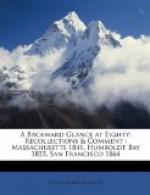Wilson came to his aid and both finally managed to climb trees beyond reach. The bear then sat down between the trees, watching both and growling threateningly if either moved. It finally tired of the game and to their great relief disappeared up the mountain. Wood, suffering acutely, was carried down to the camp, where they remained twelve days, subsisting on the bear Wilson had killed.
Wood grew worse instead of better, and the situation was grave. Little ammunition was left, they were practically without shoes or clothing, and certain death seemed to face them. Wood urged them to seek their own safety, saying they could leave him with the Indians, or put an end to his sufferings at any time. Failing to induce the Indians to take him, it was decided to try to bind him on his horse and take him along on the hard journey. He suffered torture, but it was a day at a time and he had great fortitude. After ten days of incredible suffering they reached the ranch of Mrs. Mark West, thirty miles from Sonoma. The date was February 17th, one hundred and four days from Rich Bar.
The four who started to follow the beach had experiences no less trying. They found it impossible to accomplish their purpose. Bold mountains came quite to the shore and blocked the way. They finally struck east for the Sacramento Valley. They were short of food and suffered unutterably. Dr. Gregg grew weaker day by day until he fell from his horse and died from starvation, speaking no word. The other three pushed on and managed to reach Sacramento a few days after the Wood party arrived at Sonoma.
While these adventurous miners were prosecuting the search for the mythical harbor, enterprising citizens of San Francisco renewed efforts to reach it from the ocean. In December, 1849, soon after Wood and his companions started from the Trinity River, the brig “Cameo” was dispatched north to search carefully for a port. She returned without success, but was again dispatched. On this trip she rediscovered Trinidad. Interest grew, and by March of 1850 not less than forty vessels were enlisted in the search.
My father, who left Boston early in 1849, going by Panama and the Chagres River, had been through three fires in San Francisco and was ready for any change. He joined with a number of acquaintances on one of these ventures, acting as secretary of the company. They purchased the “Paragon,” a Gloucester fishing-boat of 125 tons burden, and early in March, under the command of Captain March, with forty-two men in the party, sailed north. They hugged the coast and kept a careful lookout for a harbor, but passed the present Humboldt Bay in rather calm weather and in the daytime without seeing it. The cause of what was then inexplicable is now quite plain. The entrance has the prevailing northwest slant. The view into the bay from the ocean is cut off by the overlapping south spit. A direct view reveals no entrance; you can not see in by looking back after having passed it. At sea the line of breakers seems continuous, the protruding point from the south connecting in surf line with that from the north. Moreover, the bay at the entrance is very narrow. The wooded hills are so near the entrance that there seems no room for a bay.




